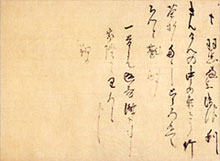| architecture |
| calligraphy |
| ceramics |
| clothing |
| comics |
| gardens |
| lacquerwork |
| literature |
| movies |
| music |
| painting |
| poetry |
| sculpture |
| tea ceremony |
| television |
| theatre |
| weaponry |
| thematic routes |
| timeline |
| the site |
context: calligraphy > Zen
Sen no Rikyu
Top page on Rikyu

|
a Rikyu letter, known as Toro no Fumi |
I'm not sure how notable Rikyu was as a calligrapher - the example shown looks pretty good to me - but I wanted to mention that an awful lot of the most treasured calligaphy was not produced as a work of art, but as some casual note or letter, as in this case. Obviously a major aesthetic figure such as Rikyu would have taken some care to write well, but I don't suppose he imagined that his letters would become museum pieces. There is an argument that this lack of self-consciousness means that the soul of the calligrapher is more directly and honestly revealed, but I think an argument that calligrapher were usually writing with some purpose in mind - perhaps persuasion, self-promotion or whatever, whether consciously or not - is equally strong, so that is just as likely to be what is on show.
Also, simple being written by a great figure makes a calligraphy valuable, whatever its artistic merits, and there are few greater figures in Japan's history than Rikyu. I suspect this would make an objective assessment of the aesthetics of a piece like that almost impossible (even if you think objective assessment of art is ever possible).
